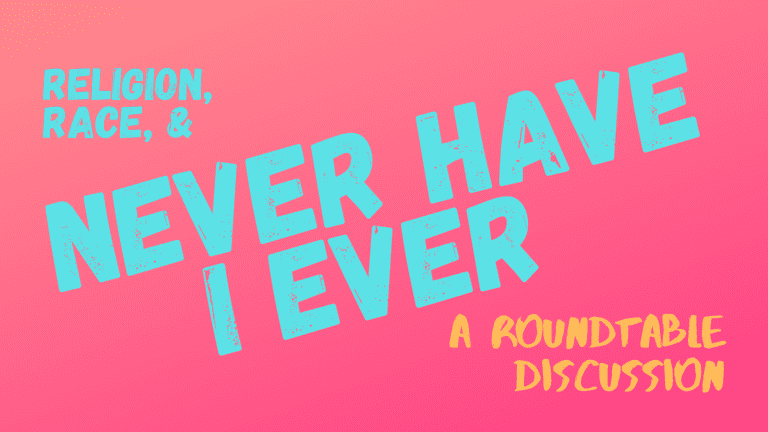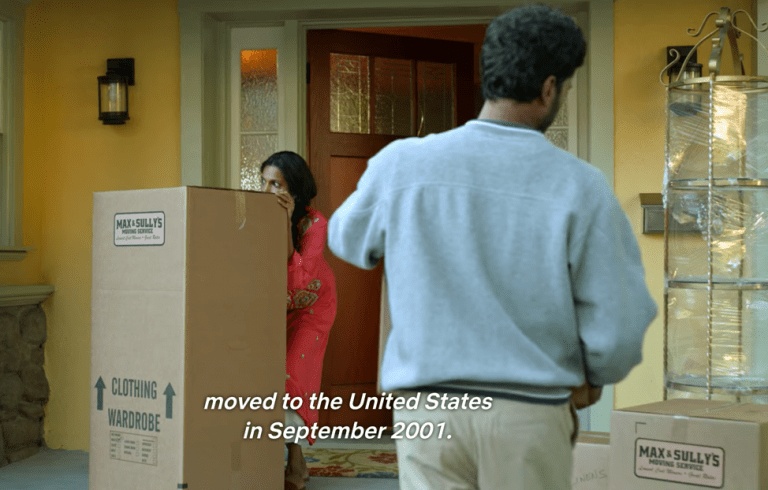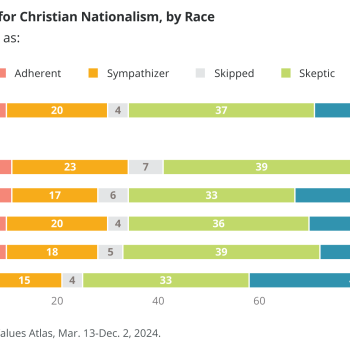As an Asian American who grew up in the 1980s and 1990s, I don’t remember seeing many American kids who looked like me on television, in film, or in books. There was Margaret Cho’s character on the short-lived show, All-American Girl–I think I saw every episode, but there was only one season. There was Trini Kwan on Mighty Morphin Power Rangers. (“Of course she was the Yellow Ranger,” my Asian American studies colleague wryly noted.) And there was Claudia Kishi in The Babysitters Club, who was Japanese American and incredibly stylish, and as the pinnacle of Asian American teen sophistication, “inspired an entire generation of Asian American writers.”
I’m relieved that now that I’m a mom, my tween daughter can see Asian Americans on screen and on the page more than ever before. From family sitcoms like Fresh Off the Boat and Kim’s Convenience to graphic novels like Gene Yang’s American Born Chinese, depictions of Asian American people are not only more common, but more complex. Never Have I Ever, Mindy Kaling’s new Netflix comedy about the misadventures of an Indian American teenager in Southern California, exemplifies how Hollywood has made tremendous progress in featuring more Asian American characters. Just as important, Hollywood has made great progress in portraying more diverse Asian American characters. On Never Have I Ever, there are Asian Americans of Indian, Filipino, Chinese, and Japanese descent. There are Asian American characters who excel at school, but also at sports and in theatre. There are mixed-race characters, foreign- and American-born characters, and straight and queer characters.
In particular, I appreciate the show’s attention to an often overlooked dimension of Asian American diversity: religion. Over the past half century, the United States has become increasingly multireligious, and the shifting demographics owe largely to Asian Americans, who are the most religiously diverse racial group in America. By and large, however, most Hollywood depictions of Asian American families do not engage in religion at all. When they do, the characters are often Christian, or they deploy problematic “Oriental Monk” tropes. (See, for example, my discussion of Marie Kondo last year.) In contrast, Never Have I Ever doesn’t shy away from portraying religion. Beginning with the opening scene of the first episode, the show portrays the rituals of an American Hindu family, and religious beliefs and practices are a central feature of the plot and the characters.
To explore how Never Have I Ever engages in themes of religion and race in contemporary Asian American life, I curated a roundtable discussion with several colleagues who have expertise in the fields of Asian American studies, religious studies, and film studies: Dr. Rupa Pillai, lecturer of Asian American Studies at the University of Pennsylvania; Dr. Himanee Gupta-Carlson, Associate Professor of Literature, Communication, and Cultural Studies at SUNY Empire State College; and Dr. Swapnil Rai, Assistant Professor of Film, Television and Media at the University of Michigan, Ann Arbor.
A warning: this roundtable contains a few spoilers, so if you haven’t seen the show yet–and we recommend you do!–consider saving this thoughtful analysis until after you’ve watched the series.
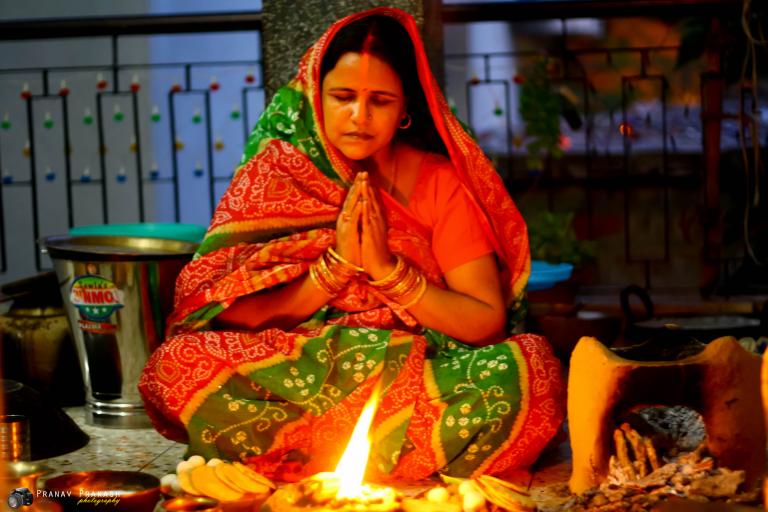
Representing American Hinduism For Whom?
Rupa Pillai
The opening scene of Never Have I Ever introduces Devi in front of an altar in her room. Before many images and murtis (statues) of deities, Devi introduces herself Judy Blume-style: “Hey Gods! Its Devi Vishwakumar, your favorite Hindu girl in the San Fernando Valley. What’s a-poppin’?” Introducing Devi by her faith is an intriguing choice by creators Mindy Kaling and Lang Fisher. Through Devi’s conversational engagement with the Divine, the showrunners attempt to demystify Hinduism to the mainstream American viewer.
Growing up in the 90s in the Bible Belt, I endured questions from my Christian schoolmates about Hinduism. Did I know what I was in a past life? Did I worship Kalimaa as depicted in Indiana Jones and the Temple of Doom? Why do you worship so many gods? Hollywood’s representation of Hinduism prompted these questions, which, as a kid who knew little about the religion and desperate to be “normal,” only exacerbated my feelings of not belonging. In the past 10 years, however, as South Asian Americans break through Hollywood’s bamboo ceiling, representation of Hinduism has changed. This is best captured by Sanjay Patel’s Sanjay’s Superteam (2015), a Pixar short that features the story of a young Hindu American boy who reimagines Hindu gods as superheroes as a way to approach praying and his faith in a manner that speaks to him. In a similar manner, Devi’s prayers capture how a Hindu American teen in Southern California might pray. In fact, the construction of the scene is reminiscent of prayers known by the Protestant Christian American majority. No ritual offerings. No chanting of Sanskrit or Tamil. Just Devi and her Gods.
The centering of Hinduism in our introduction to Devi, however, is less about exploring her relationship with faith and more about exhibiting how our collective (mis)understanding of Indian culture in the United States is reduced to Hinduism. In one of the series’ best structured sequences, Kaling alludes to America’s ignorance of South Asian religions. After posing with a white girl enamored by her half-sari, the exacerbated Devi responds to the cashier’s query about wanting donuts with her drink order: “Yeah, Ira, I do, but I’m fasting today.” Ira responds, “Oh, is it Ramadan?” This insider joke for the desi audience portrays a common encounter of being exoticized and misrecognized. Yes, Ira gets credit for knowing Ramadan is a holiday requiring fasting, but many religions require fasting. Like most Americans post 9/11, he assumes she is Muslim because of her skin, what Khyati Joshi calls the racialization of religion, when “an individual’s race creates a presumption as to her religious identity.”
Although the series does briefly point out that India is a country of many religions, ultimately to be Indian in Never Have I Ever is to be Hindu. More precisely, the Hinduism represented in the series does not capture the diversity that encompasses the religion, but privileges the values and aspirations of upper caste, middle class Hindus in the United States who embody the model minority. This Hinduism, which largely defines American Hinduism today, promotes Islamophobia, casteism, and patriarchy, which is most evident in the policing of Devi, Kamala, and Nalini, who all struggle to live up to the ideals of being a good, middle-class Hindu women in the diaspora. Like many Indian American second-generation women, Devi struggles to navigate her bicultural existence, which my co-contributor Himanee Gupta-Carlson deftly unpacks. Devi’s desires to be a “normal” American girl with a boyfriend are impeded by her mother’s expectations for her to be an accomplished, obedient daughter. Kamala struggles with her desire to pursue her professional and romantic goals and her duty to her family to marry a suitable, Hindu boy. And Nalini grapples with being a widow and a single mom in her adopted homeland without support.
We see this diasporic Hindu community most on display in episode 4, when the Vishwakumar family attends the Ganesh puja, organized by the Hindu Association of Southern California. Like most Indian cultural and Hindu events in the United States, the puja is held at Devi’s high school since most Indian American and Hindu communities lack access to stand-alone places of worship or community centers. Kaling’s decision to highlight this phenomenon is shrewd in capturing how the social dynamics of high school persist in ethnic and religious communities. If high school has mean girls, Indian/Hindu communities have aunties, who, as narrator John McEnroe aptly explains, are “older Indian women who have no blood relationship to you but are allowed to have opinions about your life and all your shortcomings.”
Aunties play a key role in communicating and enforcing the values of the Indian/Hindu American community, particularly in policing gender norms. From passive aggressive comments to straight-up shunning, aunties point out when a woman steps outside the norms established by her community. For example, an aunty underhandedly reminds Nalini of the societal expectations of her as a Hindu widow: “Your hair is so black. When my sister’s husband died, she stopped coloring her hair…. You just don’t want to give people the wrong idea.” With misogynist Hindu texts such as the Laws of Manu calling for widows to never marry again, this aunty slyly accuses her of being a bad widow and in search of a new husband. Later, to avoid further disapproval, Nalini and Kamala do not sit with a woman who married a Muslim man, an unforgiveable act in this conservative, Islamophobic community.
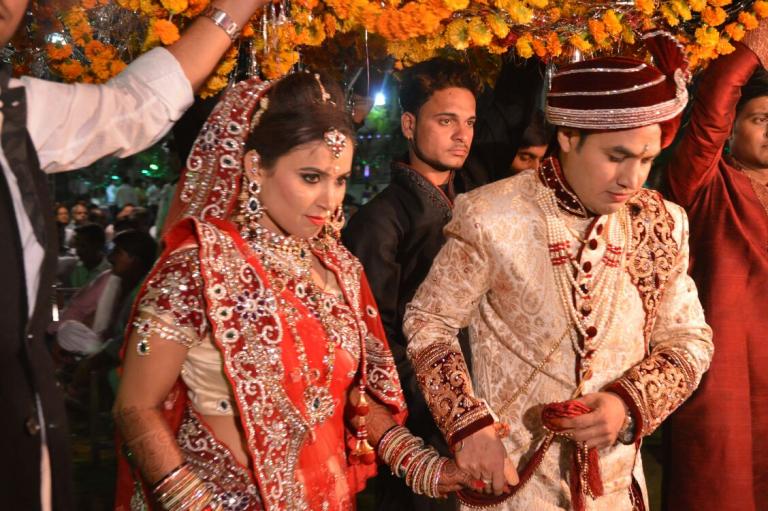
Nalini herself is an aunty, frequently disciplining Kamala into a good Hindu woman. After advising Kamala against wearing a blazer which would make her look too western, Nalini intervenes during her skype with her future in-laws. Quickly tying her hair (unbound hair in Brahmanical culture is indecent), she swoops into action: “What she loves to do is cook…. All the classics…except meat.” By focusing on vegetarian cooking, Nalini signals Kamala’s potential as a wife as well as her upper caste Hinduness. At the Ganesh puja, Nalini also pimps out her niece to deflect from Devi’s failed Hindu femininity and to reestablish their family’s standing as respectable middle-class: “You know my niece, Kamala, right? Getting her doctorate at Caltech soon to be engaged to an engineer. The boy’s parents have two Mercedes.” By listing Kamala’s accomplishments and her future husband’s wealth, Nalini clearly establishes another value of this Hindu community: success as evidenced by conspicuous consumption.
This visible success through expensive cars perpetuates the model minority narrative, where a minority community’s material success proves the United States is a colorblind, meritocracy. Like the Jewish American community, Hindu Americans are assumed to be successful because of their culture, values, and work ethic. Much of Never Have I Ever is structured to promote this comparison. Devi’s academic nemesis is Ben Gross, a Jewish American boy who constantly boasts about his entertainment lawyer father. While Devi competes with Ben scholastically, she also draws comparison with him materially: “Why does the Hindu Association have to have puja at my high school? It is so low rent. Ben Gross’s Bar Mitzvah was at the Dolby Theatre.” Ben’s family also exemplifies this materialism through their impressive house and their courtside seats to the LA Clippers (although, I have to agree with Shira, no one wants to see Billy Crystal eat nachos). However, this materialism is not rewarding. Ben is alone as his father works constantly to afford these luxuries while the women in his life, his mother and his girlfriend, fall into the stereotypes of Jewish American Princesses who, in the words of Karen Brodkin, “embody the horrors of the too-white and joylessly passive consumer culture.”
My issue with Ben and Devi’s obsession with materialism is that it obscures the privileges that enable them to succeed in this manner. As Karen Brodkin argues in How Jews Became White Folks (1998), Jewish Americans became “successful” when they gained access to institutional privileges of whiteness post World War II. These privileges removed economic and social barriers enabling Jewish Americans to become American by participating in middle-class materialism. Likewise, many Indian Americans engage in conspicuous consumption antics because of selective migration, as Vijay Prashad argues. Prashad points out that, for many, their caste privilege in India facilitated their ability to attain professional degrees, to immigrate to the United States, and to commodify their culture/religion in this manner. By obscuring this, Never Have I Ever’s representation problematically flattens the South Asian American community, ultimately hiding the inequalities that persist in this community and the greater American society. The normalizing of this Indian/Hindu American experience in Never Have I Ever as well as Bravo’s Family Karma (2020) perpetuates existing definitions of whiteness and our complicity in anti-blackness and settler colonialism to be accepted as American. In the wake of more critical representations of South Asian Americans that educate as they entertain, like Patriot Act with Hasan Minhaj (2018) and Brown Girls (2017), Never Have I Ever seems disconnected with today’s desi community, which includes a small, but growing contingent reckoning with caste and organizing against Modi. While my co-contributor Swapnil Rai is right to point out the unfairness of expecting Kaling to create a show that represents the Indian American community in all its diversity, I am reminded of my schoolmates in Texas and how Hollywood representations shaped their understanding of Hinduism. Our community needs to resolve the“deep seated ideological and political ambiguity” Rai alludes to by asking what is gained by normalizing the Indian/Hindu American community in this manner? And while this may be a comic satire, the nuance may not register with the larger American public, raising the question, how are they laughing?
Dismantling the Model Minority Myth and Creating a New Multiracial Society
Himanee Gupta-Carlson
I live in the present but also my 1970s past. That was when I was an American-born Indian (ABI) teenager like Devi Vishwakumar, the main character in the Netflix series Never Have I Ever. That co-existing of present and past creates the space for a future, where power resides in the bodies of African American women who are principals, PTA leaders, and therapists and the main goal is to dig deep into the pain, anger, shame, and grief of the past in order to heal.
A growing number of young adult novels written by and featuring South Asian American women writers offer one space for such healing in popular culture. These novels create in the words of Rudine Sims Bishop “mirrors” for seeing one’s self and “windows” for imagining a more diverse world. Never Have I Ever offers a similar space.
To be sure, these spaces are idealistic and, as a result, flawed. Most of the young adult novels take place in affluent Silicon Valley type communities with brilliant high school students who are Ivy League bound. Similarly, in Never Have I Ever, Devi lives in the San Fernando Valley, is brainy and hoping to get into Princeton. She and her friends appear to have plenty of money. Asian Americans make up the majority with whites mingling in, and Blacks playing a quiet but, as I shall show later, key role on the sidelines.
This was a far cry from my 1970s life as a daughter in one of a handful of immigrant Indian families in Muncie, Indiana, where whites were a decided majority, African Americans a much smaller but visible minority, and Asian Americans virtually invisible. In that world, John McEnroe was the bad boy of tennis who mouthed off to referees and took the Grand Slam title away from my hero, the good-tempered blonde Swede Bjorn Borg.
Rupa Pillai shows how the portrayal of Hindu practices is overly simplistic, which does nothing to educate viewers about the rich complexity of Hinduism and the multiple ways it is practiced. Pillai also rightfully points out that the absence of non-Hindus has the effect of conflating Indian-ness with Hinduism, thus masking the linguistic, ethnic, and religious diversity of the diaspora Indian community. Furthermore, as Swapnil Rai notes, the economic and social positioning of Devi’s family within the series’ constructed diaspora community conveys a sense that all Indians in America are successful “model minorities.”
Yet, by artfully flipping some of the racial and gender power relations that govern society, Never Have I Ever creates a potential space through which one can start to dismantle the model minority rubric and look at what it means to live in a multi-racial society.
One striking characteristic of Devi is color. She is dark-skinned, a physical trait suggestive of blackness. In a white supremacist America, blackness often carries connotations of being foul, threatening, unsightly, and below that of others. Devi exhibits some of these characteristics in her behavior. She has a hot temper, is self-absorbed, and disobeys her mother who finds her difficult to control.
Devi’s dark skin differs from the light tones of her cousin Kamala, who has come from India for graduate school. Kamala is unselfish and on the surface obedient. She is the dutiful daughter that Devi is not, which Devi’s mother Nalini reminds her of often.
These associations of skin tone with behavior give us a glimpse of how caste and colorism interact. Kamala goes through the motions of agreeing to an arranged marriage while sleeping with Steve, who is of Chinese American and a hunk. When Kamala drops him, he is mistaken for a window washer, tree trimmer, and roof repair man – working class positions well beneath the superior societal position that high-caste Indians claim for themselves.
Nalini is also fair-skinned. As she disciplines Devi, caste-based prejudices surface. After a night when heart-throb Paxton drives Devi home and kisses her goodnight, Nalini berates her daughter for sneaking out of the house and Paxton for ruining the reputations of her daughter and other young women. As Paxton tries to explain that they only kissed, she equates his poor grades with inferiority as if getting into an Ivy League college were the only thing that mattered.
These confrontations are tempered by Mohan – Devi’s father who died unexpectedly a year earlier and whose memories haunt her. Mohan, like Devi, is dark skinned and shows up to remind Devi that she is beautiful. His favorite tennis player is not Bjorn Borg but John McEnroe, whose talent and audacity he tells Devi to emulate.
This advice flips the meaning of bad behavior, just as it flipped my memories of McEnroe. McEnroe was red-headed and abrasive. He and Borg battled from 1978-81 in 14 Grand Slam tournaments. Borg never lost his temper; McEnroe did so often. McEnroe’s behavior spoke truth to power and exposed the genteel patina of professional tennis.
Internalized racism might have made me like Borg, afraid as a teen to challenge the normative whiteness around me much as Kamala fears the repercussions of refusing an arranged marriage. Devi, as McEnroe, is fully prepared to battle such normative views.
Battling normativity is part of the good social justice fight. Yet, fighting is fruitless without healing from pain. Overcoming my own internalized shame for not being normatively white in Indiana as a teen has meant acknowledging the pain that racism has wrought in me and caused me at times to inflict upon others. For Devi, the healing starts first with confronting the night of Mohan’s death and how it revealed her fractious relationship with her light-skinned mother. For Nalini, too, it means learning to let go of control and to let others in the multiracial milieu that shapes Never Have I Ever take charge of the world.
That this advice comes from a therapist who is African American is significant in that it reveals the limits of white dominance while allowing us to creatively concoct a new space.
The In-Between World of the Indian Diaspora in the United States
Swapnil Rai
Never Have I Ever, Mindy Kaling’s Netflix series, marks a first in terms of South-Asian/Indian-American representation on television. Although, American TV has come a long way since Apu on The Simpsons and lately many shows (The Office, The Big Bang Theory) have had a token South Asian ensemble character. This tokenistic nod purportedly “shifted” in favor of more substantial representation when Bollywood cross-over star Priyanka Chopra got hired by ABC to play the lead in their FBI drama, Quantico. Chopra’s character, looked like a bronzed Latina, had a generic name and the only markers of her part-Indian, part-Hindu identity were her Om tattoo and a temple in her room. Chopra’s character in Quantico dabbled in generalizations with very few specifics about her cultural identity. The star herself confessed that Alex’s character made her confused. Alex is eventually accused of terrorism and spends most of the series attempting to prove her innocence.
Never Have I Ever gives us a teenage protagonist who pines for the “beauty of Priyanka Chopra,” yet confesses to her very real struggle with hairy arms and qualifies it as an “Indian thing.” In contrast to a show like Quantico, Never Have I Ever presents a very specific flavor of a hyphenated Indian American Hindu identity. Kaling defines the temporal, historical moment when Devi’s parents move to the United States as 2001, the moment of the dotcom bubble. Through other markers such as vegetarianism and emphasis on rituals like getting textbooks blessed at the temple, the show foregrounds a distinctive high caste, high class, South Indian American Hindu identity born out of Kaling’s personal experience. Like Never Have I Ever’s protagonist Devi, Kaling possesses all the markers of social and cultural capital embodied in a mainstream South Asian American Hindu identity. Like Devi, who nurtures dreams of attending Princeton one day, Kaling’s posh private high school experience was followed by a degree at Dartmouth. While our politically conscious selves might possibly cringe at these descriptors of caste and class hierarchy because, as Rupa Pillai points out, they replicate the values, aspirations and myths of the model minority, I want to shift our focus to the in-betweenness of this Hindu Indian American community, an in-betweenness that stems from a majority-minority dilemma. The fact that a high caste, high class Hindu is a majoritarian (somewhat elite) identity in India but that the same markers relegate this community to a marginalized sub-group in the United States epitomizes this dilemma. Indian Americans struggle to find a place and belonging – constantly suffering the perpetual guest syndrome. This in-betweenness also fuels deep political schisms that engender opposing responses to populist authoritarianism in India versus the United States. The world Kaling has created through Never Have I Ever mirrors the microcosm of Indian Americans in a nuanced manner, as Himanee Gupta-Carlson points out. To fault it for its “problematic” representation of South Asians/Indians in the United States is to elide the specificities of U.S. immigration laws that enabled a pattern of migration that was accessible only to the privileged.
A 2005 article in the Time points out that that Indian population in the United States more than doubled between 1990s and early 2000s and that the median household income for this group was 50% higher than the national average. As of 2015, there were approximately 3.9 million Indians in the United States, and according to the Pew Research Center, over forty percent of this population had a post-graduate degree and a median income of $100,000 a year. U.S. immigration policies with respect to India privileged a specific type of immigration that created a highly skilled and educated immigrant workforce which played an important role in reproducing the Indian-South Asian community as a model minority. Hindus, Pew found, are by far the highest educated religious group in the United States. The highly skilled, highly educated workforce of Hindu Indians in the United States is built upon various kinds of social and cultural capital and class/caste/religion-based privilege.
Viewed from this lens Never Have I Ever gives us a very specific representation that mirrors the predominant South Asian American Hindu experience. There is merit in foregrounding specific stories because they give us the space to explore the ideological in-betweeness of this diaspora. Hence, Devi’s mother Nalini’s remarks about the Indian Prime Minister using Postmates being akin to the Indian Priest using Uber should come as no surprise. It indicates the exceptional status of both the priest and Modi within the religious and political milieu of this community. It points to the dialectical push and pull of ideologies that Hindu South Asian Americans suffer from. Populist authoritarianism is welcomed by them in India but rejected in America because of their marginal subjectivity. We are after all the community that hosted Trump and Modi together at “Howdy Modi” in Houston, Texas in September, 2019.
The Ganesh Puja episode similarly situates the primacy of religion within this community. However, Kaling wants us to register the second-generation’s rejection of their Hindu-Indian-ness. Never Have I Ever’s protagonist Devi wants to reject the hyphen and claim her “all American” identity but somehow can never do away with the cultural baggage, the aunties, and most of all the colorism/racism that exists both within and beyond the hyphen.
I agree that Kaling’s representation is not encompassing all of the many South Asian identities. But I believe that the show’s value lies in its specificity. It pronounces long-winded sanskritized names like Devi Vishwakumar and normalizes them. At the same time, it provides us a window into the deep-seated ideological and political ambiguity of this dominant demographic, an ambiguity that fails to introspect and recognize the community’s collective privilege, yet pays sanctimonious lip service to inclusion and diversity. As Stuart Hall has argued, identity is constituted in representation, but identity is also dialectical and inflected by representation. If we are that classist, caste-ist community, how can we expect our representation to be different? But then again, we should take heart in the fact that Kaling’s genre is comic satire.


